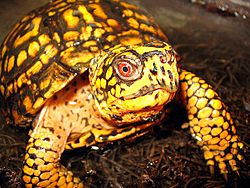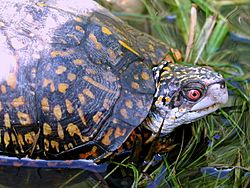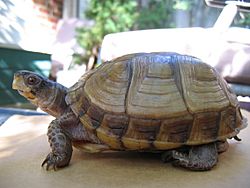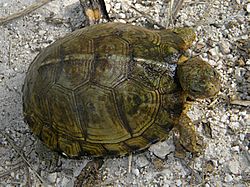Common box turtle facts for kids
The common box turtle (Terrapene carolina) is a type of box turtle with six different kinds, called subspecies. You can find these turtles across the Eastern United States and in Mexico. They have a special lower shell that can close up like a box. This helps them hide their head and legs completely inside. Their upper jaw is also long and curved.
These turtles mostly live on land. They eat many different plants and animals. Female turtles lay their eggs during the summer. Turtles that live in colder northern areas sleep through the winter. This is called hibernation.
Sadly, the number of common box turtles is going down. This is because they are losing their homes, getting hit by cars, and being caught for pets. The IUCN Red List says they are a vulnerable species. This means they are at risk of disappearing. Three U.S. states have even named a common box turtle subspecies as their official reptile.
Quick facts for kids Common box turtle |
|
|---|---|
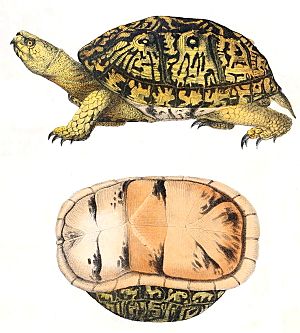 |
|
| 1842 drawing | |
| Conservation status | |
| Scientific classification | |
| Genus: |
Terrapene
|
| Species: |
carolina
|
| Subspecies | |
|
See text |
|
| Synonyms | |
|
|
Contents
What is a Common Box Turtle?
The common box turtle gets its name from its amazing shell. This shell has a high, rounded top part called a carapace. It also has a big, hinged bottom part called a plastron. This hinge lets the turtle close its shell tightly. It seals its head and legs safely inside, like a strong, protective box.
The top shell is usually brown. It often has cool patterns of orange or yellow lines, spots, or blotches. The bottom shell is dark brown. It might be plain or have darker smudges.
How to Tell Males and Females Apart
Common box turtles have a small to medium-sized head. They also have a unique hooked upper jaw. Most adult male turtles have red eyes. Females, however, have yellowish-brown eyes. Males also have shorter, thicker, and more curved claws on their back feet. Their tails are longer and thicker than females' tails.
There are six living subspecies of the common box turtle. Each one looks a little different. These differences are mostly in the color and patterns of their top shell. They also might have three or four toes on each back foot. The subspecies Terrapene carolina triunguis is special because most males have a bright red head.
Where Do Common Box Turtles Live?
Common box turtles live in many places across the eastern United States. You can find them in open woodlands, along roads, in marshy meadows, and in brushy grasslands. Their range stretches from Maine and Michigan down to eastern Texas and south Florida.
They are also found in Canada, in southern Ontario. In Mexico, they live along the Gulf Coast and in the Yucatán Peninsula. The two Mexican subspecies, T. c. mexicana and T. c. yucatana, are separated from the U.S. turtles by a gap in western Texas.
Three U.S. subspecies are found in areas matching their names. These are the eastern box turtle (T. c. carolina), the Gulf Coast box turtle (T. c. major), and the Florida box turtle (T. c. bauri). The three-toed box turtle (T. c. triunguis) lives in the central United States.
Common Box Turtle Behavior and Life Cycle
Common box turtles are mostly land animals. You often see them early in the day or after it rains. They come out from under leaves, logs, or animal burrows to find food. These turtles eat a huge variety of things. Their diet includes earthworms, slugs, insects, wild berries, and sometimes even dead animals.
In hot summer months, you might find them near swamps. They do this to stay cool. If a common box turtle gets too hot (around 32°C), it will put saliva on its legs and head. As the saliva dries, it helps cool them down. They might also pee on their back legs to cool parts of their body they can't reach with saliva.
Reproduction and Eggs
Courtship for common box turtles usually happens in spring. It starts with the male circling, biting, and pushing the female. After some pushing and shell-biting, the male holds onto the back of the female's shell with his back feet. This lets him lean back to mate with her. Amazingly, female common box turtles can store sperm for up to four years after mating. This means they don't need to mate every year to lay eggs.
In May, June, or July, females usually lay 1 to 11 eggs. They dig a flask-shaped nest in sandy or loamy soil. The eggs hatch after 70 to 80 days. The tiny baby turtles come out of the nest in late summer.
Hibernation and Lifespan
In the northern parts of their home range, common box turtles may start to hibernate in October or November. They dig into loose soil, sand, plant matter, or mud at the bottom of streams. They might also use an animal's burrow. They stay in their chosen shelter until the cold winter is over. Common box turtles are known to live a very long time. One turtle was known to be at least 138 years old!
Protecting Common Box Turtles
Even though common box turtles live in many places and used to be common, their numbers are going down. Many things threaten them. Building new farms and cities is destroying their homes. Also, human activities like controlling fires are harming their habitats. More buildings mean more roads, and turtles often get hit by cars on these roads. People collecting them for the international pet trade also hurts their populations in some areas.
Common box turtles live a long time and have a slow rate of reproduction. This makes them very sensitive to these threats. Because of this, the common box turtle is listed as a vulnerable species on the IUCN Red List. It is also listed on Appendix II of the Convention on International Trade in Endangered Species. This means that international trade of these turtles should be watched carefully. This helps make sure it doesn't harm the turtles' survival. Many U.S. states now have rules to protect this species.
These turtles also live in protected areas. Some of these areas are big enough to keep them safe from development. They might also live in the Sierra del Abra Tanchipa Biosphere Reserve in Mexico. To help common box turtles, experts suggest managing urban developments in ways that are friendly to these turtles. They also recommend more research into their lives and keeping track of their populations.
State Reptiles
Common box turtles are the official state reptile of four U.S. states. North Carolina and Tennessee honor the eastern box turtle. Missouri chose the three-toed box turtle. Kansas picked the ornate box turtle in 1986.
In Pennsylvania, a bill to make the eastern box turtle the state reptile passed one part of the government but failed in 2009. In Virginia, similar bills failed in 1999 and 2009. For the most recent failure, one politician said the turtle was "cowardly" because of its shell. However, the main reason it failed in Virginia was that the turtle was too closely linked to their neighbor state, North Carolina.
This article incorporates text from the ARKive fact-file "Common box turtle" under the Creative Commons Attribution-ShareAlike 3.0 Unported License and the GFDL.
Images for kids
See also
 In Spanish: Tortuga de caja común para niños
In Spanish: Tortuga de caja común para niños



